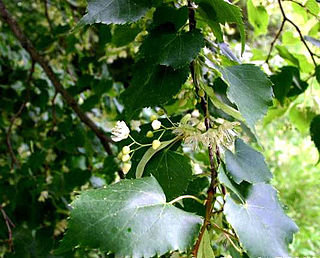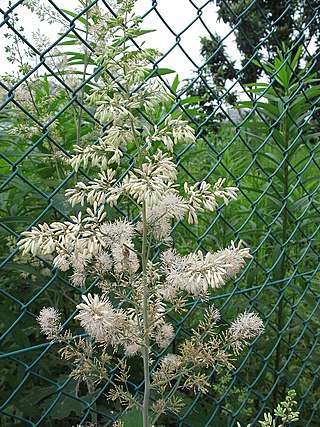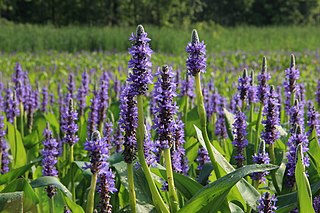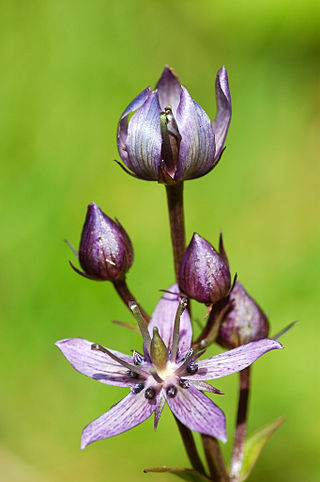
Tilia is a genus of about 30 species of trees or bushes, native throughout most of the temperate Northern Hemisphere. The tree is known as linden for the European species, and basswood for North American species. In Britain and Ireland they are commonly called lime trees, although they are not related to the citrus lime. The genus occurs in Europe and eastern North America, but the greatest species diversity is found in Asia. In Chinese, "椴/duàn" or "椴樹/duànshù" is a general term for Tilia species. Under the Cronquist classification system, this genus was placed in the family Tiliaceae, but genetic research summarised by the Angiosperm Phylogeny Group has resulted in the incorporation of this genus, and of most of the previous family, into the Malvaceae.

Tilia cordata, the small-leaved lime or small-leaved linden, is a species of tree in the family Malvaceae, native to much of Europe. Other common names include little-leaf or littleleaf linden, or traditionally in South East England, pry or pry tree. Its range extends from Britain through mainland Europe to the Caucasus and western Asia. In the south of its range it is restricted to high elevations.

Cryptocoryne is a genus of aquatic plants from the family Araceae. The genus is naturally distributed in tropical regions of India, Southeast Asia and New Guinea.

Alnus cordata, the Italian alder, is a tree or shrub species belonging to the family Betulaceae, and native to the southern Apennine Mountains and the north-eastern mountains of Corsica. It has been introduced in Sicily, Sardinia, and more recently in Central-Northern Italy, other European countries and extra-European countries, where it has become naturalised.

Houttuynia cordata, also known as fish mint, fish leaf, rainbow plant, chameleon plant, heart leaf, fish wort, or Chinese lizard tail, is one of two species in the genus Houttuynia. It is a flowering plant native to Southeast Asia. It grows in moist, shady locations. It was named after Martinus Houttuyn.

Aralia cordata is an upright herbaceous perennial plant growing up to 2 to 3 metres in height, native to Japan, Korea and eastern China. Its common names include spikenard, herbal aralia, udo, Japanese spikenard, and mountain asparagus. It is commonly found on the slopes of wooded embankments. Aralia cordata is a species of Aralia in the family Araliaceae.

Chaenostoma cordatum, also known as Sutera cordata, Bacopa cordata, Sutera diffusus, or Bacopa, is one of 52 species in the genus Chaenostoma (Scrophulariaceae), and is native to South Africa.

Macleaya cordata, the five-seeded plume-poppy, is a species of flowering plant in the poppy family Papaveraceae, which is used ornamentally. It is native to China and Japan. It is a large herbaceous perennial growing to 2.5 m (8 ft) tall by 1 m (3 ft) or more wide, with olive green leaves and airy panicles of buff-white flowers in summer.

Neottia cordata, the lesser twayblade or heartleaf twayblade, is an orchid of upland bogs and mires that rarely exceeds 15 cm (5.9 in) in height. It was formerly placed in the genus Listera, but molecular phylogenetic studies have shown that Neottia nidus-avis, the bird's-nest orchid, evolved within the same group.

Swertia is a genus in the gentian family containing plants sometimes referred to as the felworts. Some species bear very showy purple and blue flowers. Many members of this genus have medicinal and cultural purposes.

Pontederia cordata, common name pickerelweed (USA) or pickerel weed (UK), is a monocotyledonous aquatic plant native to the American continents. It grows in a variety of wetlands, including pond and lake margins across an extremely large range from eastern Canada south to Argentina. A few examples include northern rivers, the Everglades and Louisiana.

Frasera, the green gentians, is a genus in the gentian family, native to North America and named for John Fraser, a Scottish botanist and colleague of Thomas Walter.
Frasera fastigiata is a species of flowering plant in the gentian family known by the common name clustered green gentian. It is native to the northwestern United States, where it grows in meadows and other mountain habitat. It is a perennial herb producing a single stem which grows erect and often exceeds a meter in height. The basal leaves have oval or spoon-shaped blades up to 30 centimeters long by 10 wide. Leaves higher on the stem may be smaller and narrower. Some of the leaves have white margins. The inflorescence is a dense panicle atop the stem, sometimes interrupted into a series of clusters of flowers. Each flower has a corolla of four pointed lobes each roughly a centimeter long. They are greenish, often tinged with yellow or blue. There are four stamens tipped with large anthers and a central ovary.

Swertia perennis is a species of flowering plant in the gentian family known by the common names felwort and star swertia. It is native to several regions of the northern hemisphere, including much of Eurasia and western North America. It is a plant of wetlands, particularly calcareous fens. It is common to abundant in many areas, but it is known to be negatively impacted by habitat fragmentation and other habitat destruction, and human activity has led to its extirpation from some areas where it was once common. It is a perennial herb producing usually one erect stem growing 10 to 50 centimeters tall. The basal leaves are spoon-shaped with rounded tips, and leaves higher on the plant are widely lance-shaped or somewhat oval, with pointed tips. The inflorescence is an open panicle of flowers atop the stem. Each flower has a calyx of four or five pointed sepals and a corolla of four or five pointed lobes each up to 1.3 centimeters long. The corolla is dull blue to violet in color with darker purplish veining or stippling. There are two rounded nectary pits at the base of each lobe of the corolla. Stamens tipped with large anthers surround a central ovary.
Swertia punicea is a plant species in the genus Swertia.

Pyrus cordata, the Heart-leaved pear or Plymouth pear, is a rare wild species of pear belonging to the family Rosaceae. It gets its name in Spanish, Portuguese and French from the shape of its leaves. In the UK, it is known as Plymouth Pear after the city of Plymouth in Devon, where it was originally found in 1870 The Plymouth pear was one of the British trees to be funded under English Natures Species Recovery Programme.
Cucurbita cordata is a species of flowering plant in the squash family. It is similar to Cucurbita californica, Cucurbita cylindrata, Cucurbita digitata, and Cucurbita palmata and all these species hybridize readily. These species form the only restricted xerophyte species group in the genus Cucurbita. Each member of this species group is native to the Southwestern United States and Northwestern Mexico where they are relatively uncommon. Each group member is found in hot, arid regions with low rainfall. They prefer soil that is loose, gravelly, and well-drained. C. cordata is found only in the vicinity of Bahía de los Ángeles, Baja California. Botanists Bemis and Whitaker suggest that C. cordata and C. cylindrata may be a case of sympatric speciation. The juvenile leaves of C. cylindrata, C. cordata, C. digitata, and C. palmata show a high degree of similarity, but their mature leaves are visibly different, as are their root structures. C. cordata fruits are gray green, striped, and round.
Cucurbita cylindrata is a species of flowering plant in the squash family. It is similar to Cucurbita californica, Cucurbita cordata, Cucurbita digitata, and Cucurbita palmata and all these species hybridize readily. These species form the only restricted xerophyte species group in the genus Cucurbita. Each member of this species group is native to the Southwestern United States and Northwestern Mexico where they are relatively uncommon. Each group member is found in hot, arid regions with low rainfall. They prefer soil that is loose, gravelly, and well-drained. C. cylindrata is found only in the middle portion of Baja California, mostly in Baja California Sur. Botanists Bemis and Whitaker suggest that C. cordata and C. cylindrata may be a case of sympatric speciation. The juvenile leaves of C. cylindrata, C. cordata, C. digitata, and C. palmata show a high degree of similarity, but their mature leaves are visibly different, as are their root structures. C. cylindrata fruits are dark green, striped, and round.

Ficus cordata, the Namaqua rock fig, or Namaqua fig is a species of fig that occurs in two disjunct populations in Africa, one in the arid southwest of the continent, and a second in the northern subtropics. In the south it is often the largest and most prominent tree, and is virtually restricted to cliff faces and rock outcrops, where it has a rock-splitting habit.

Mickelopteris is a genus of ferns in the subfamily Cheilanthoideae of the family Pteridaceae with a single species Mickelopteris cordata. Synonyms include Parahemionitis cordata and Hemionitis cordataRoxb. ex Hook. & Grev. The species is native to south-eastern Asia, from India to Taiwan and the Philippines.















